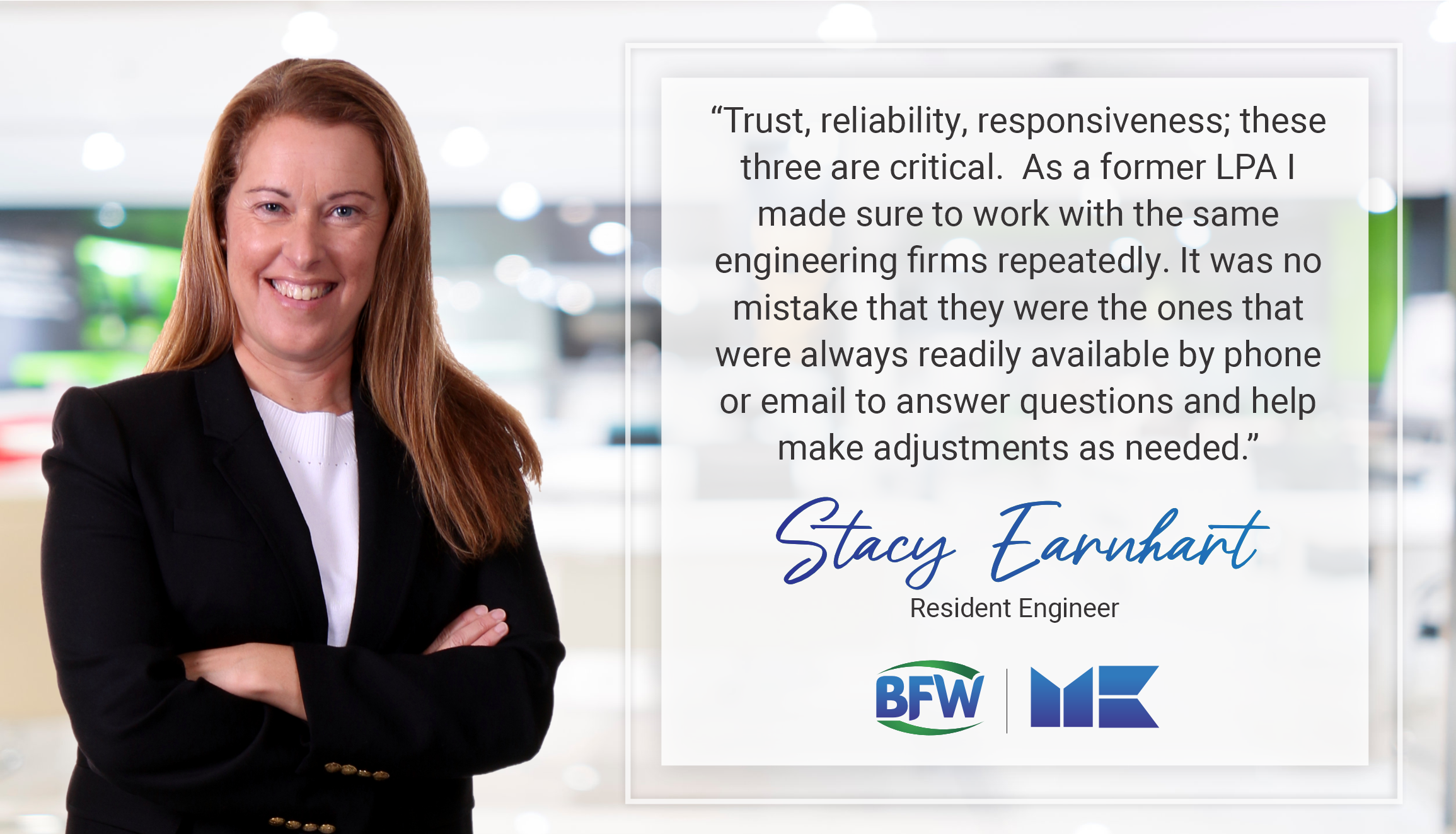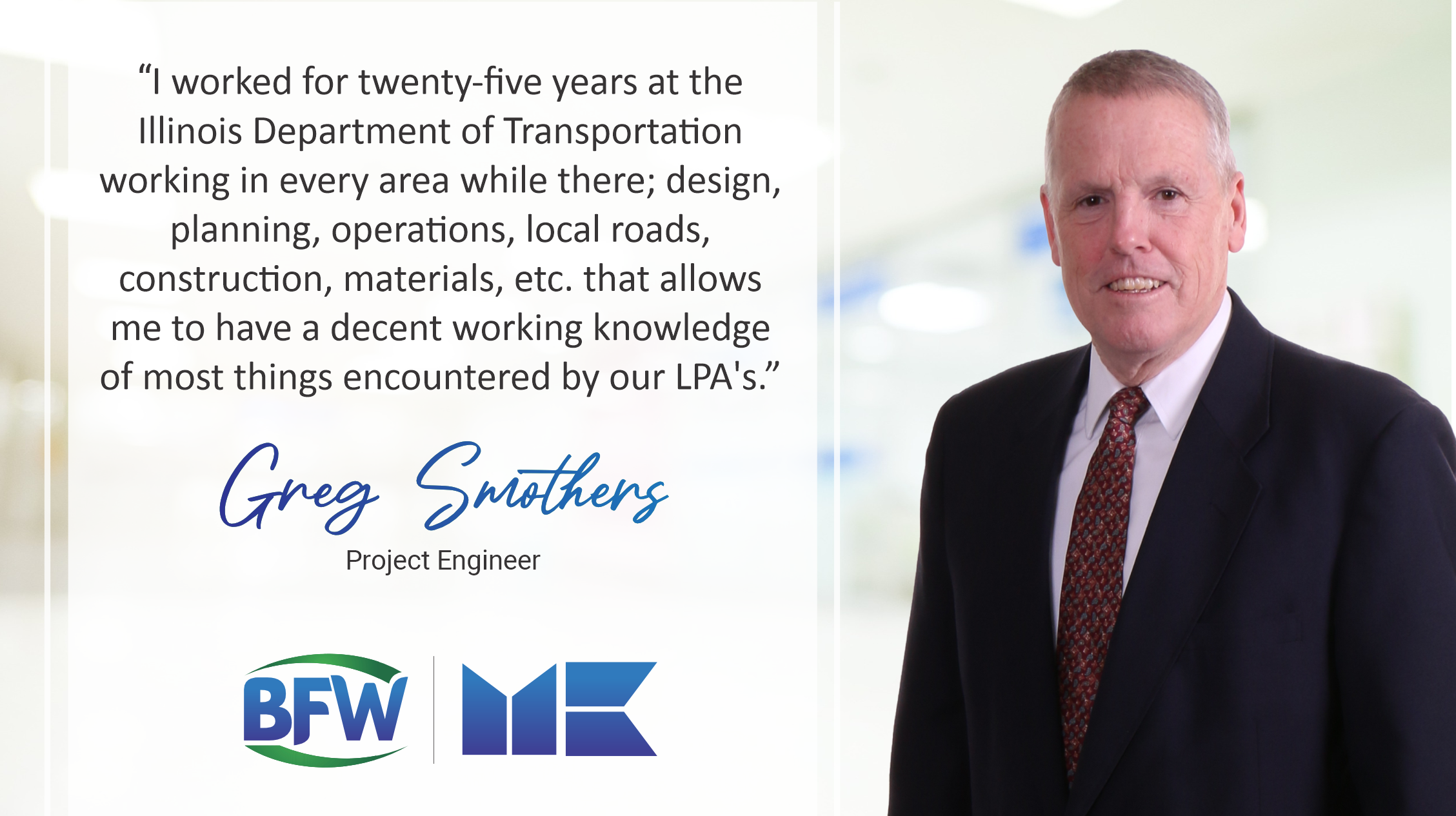Local Public Agencies—the Stewards of Infrastructure
How does a park, bridge, or roadway stay maintained? Beyond that, how do new structures even get off the ground? One of the many proponents, or stewards, of these new and ongoing public projects are Local Public Agencies (LPAs)—they act as the official body empowered under State law to plan and undertake a local transportation program with State and Federal assistance. An LPA may be a city, county or other governmental entity, or a separate body such as a redevelopment agency or a local housing authority.
Of course, an LPA is the unit of government that controls and maintains these projects. They need the expertise” to help design and build the worthwhile projects looking for. That’s where a firm like BFW/Marcum comes in.
We Cultivate Trust & Provide Reliability
“First and foremost,” explains Greg Smothers, Project Engineer, “we want to be the trusted, reliable resource for our LPAs. We understand their needs given that they work with very limited budgets and resources. They are equally important to the FHWA and IDOT as they are the transportation system most people use daily.”
Greg brings up a valuable point. Much of the work we do with LPAs goes unseen. It’s the pivotal but unflashy work assisting LPAs to deliver their annual transportation program. LPAs have specific projects they need designed and developed that will be consistent with their overall transportation system. They trust that, through working with a firm like ours, these projects are timed, prioritized, and budgeted correctly.
Stacy Earnhart, Resident Engineer, was once an LPA herself, which means she was on the other side of things. “I started at IDOT in college, after college I worked in design at MoDOT. After leaving MoDOT, I had the opportunity to serve as county engineer of my home county, work as a construction inspector, and most recently I work for BFW/Marcum.”

She knows exactly what an LPA is looking for. “Trust, reliability, responsiveness; these three are critical. As a former LPA I made sure to work with the same engineering firms repeatedly. It was no mistake that they were the ones that were always readily available by phone or email to answer questions and help make adjustments as needed.”
Do More with Less
When it comes to infrastructure work, especially within the guidelines of our LPA partners, efficiency is key. Here at BFW we work hard with our LPA partners to coordinate all aspects of a job to meet their needs. There is always something to do, so doing it well, within budget, and at the right time is critical to our LPA partners.
Often it can be a challenge to set up program funding for various projects needed due in part to the way project costs are escalating right now in the industry along with how federal funds trickle down to LPAs to fund their infrastructure projects. In many cases, infrastructure that is in dire need of upkeep doesn’t qualify for federal funding, so the state and local agencies must get creative. Locally, they’ve found that the best way to stretch their budget is using engineering firms like ours—we know how to stretch a dollar!
“Federal roadway projects are generally funded at 80% via federal funds and 20% via local revenue. Township bridge projects are funded at 80% via the Township Bridge Program and 20% local revenue.” Explains Greg.
“Our local public agency partners prefer to utilize engineering firms to design their projects with engineers they know and trust to deliver the project that they need. Building relationships and trust among our local public agencies is an absolute key to how BFW helps our local partners succeed.”
Joe Matesevac, another Project Engineer that works closely with LPA contracts, chimes in as well. “Engineering contracts are usually selected by the LPA. If the engineering scope is over a certain threshold, then an LPA must choose based on something called a Quality Based Selection process, a merit-based selection process where many things including experience play a part in selection. If it is under a certain threshold, usually the best working relationship prevails. Luckily, we are both a highly skilled and highly regarded engineering firm in the region, so that helps on both fronts.”
“To put it simply,” Stacy explains. “An LPA might have the money, but we have the bandwidth. Typically, government/agencies send out grant funding opportunities, but LPAs often do not have staffing/time to complete all the paperwork so providing the service would be beneficial as long as the LPA is committed to the process. Our job as the engineering firm is to best use the money provided to LPAs, no matter what the source is. There is a community service aspect to it, for sure.”
Relationships and Experience Matters
“There is no real given for this kind of thing,” explains Joe. “Rather, for LPA’s, our working relationship with the local agency is usually the biggest factor in selection of BFW/Marcum as the engineer.
Job performance speaks volumes. If we design something that is constructed seamlessly with little to no problem, then usually an LPA will keep using us as long as the relationship with them is kept up. If mistakes are made and it makes it harder on LPAs on the back end of a project, that is a detriment to an engineering firm.”

“Money talks, though.” Adds Greg. “One item that truly assists these agencies is by doing the work necessary to bring ‘added’ grant dollars into their county or city. Grant dollars are available for our LPAs at the state and federal levels. It takes a great deal of time and expertise when pursuing these grant dollars. Time many of our LPA’s don’t have time for with the busy schedules they keep. However, grant writing is one of the many services we excel at.
LPA budgets are already so squeezed that if we can get them a grant for $1M to help then resurface a road or upgrade an intersection, it can bring a brand-new avenue of usefulness to them. Add that on to the already good work we are doing, and you can bring true value to them. Within the FHWA and IDOT, there are a ton of grant opportunities we can pursue to help them fund needed projects within their jurisdictions at a much lower cost to them. Many times. LPA clients are surprised by the added revenues available within reach if you provide the tools to hook into it.”
Our Engineers are the Best
No, really. We can argue this point until you concede because we’d never stop advocating for our engineers. Greg Smothers and Joe Matesevac are two great examples. They’re not just awesome engineers, but two individuals that understand the dynamic of the types of projects and relationships they get into with LPA projects.
Greg’s experience with this type of work is exhaustive. “I worked for twenty-five years at the Illinois Department of Transportation working in every area while there; design, planning, operations, local roads, construction, materials, etc. that allows me to have a decent working knowledge of most things encountered by our LPA’s. My last 11 years at IDOT, I was Bureau Chief of Operations and Project Implementation overseeing the district operations/projects.

Following my time at IDOT, I worked 10.5 years aa the Williamson County Engineer overseeing a road network of roughly 650 miles. This gave me intimate knowledge of the technical and financial challenges that so many of our local agency partners encounter.”
Joe, like Greg, has an in-depth understanding of the hoops, red tape, and red flags of the trade. “I was a County Engineer in Massac County (far Southern Illinois) for 10 years. I was on the other side of the project for many, many years, so I bring that perspective and it translates to a patience and empathy for our LPA clients, who may have different priorities than our state or federal clients.”
Let’s Keep the Complicated as Simple as Possible
We won’t sugarcoat it; keeping our country in good shape is a complicated, almost impossible task. There’s simply so much of it, and only so many resources to go around. That is precisely why we love to work with LPAs. We’re not just engineers; we’re big-picture people with large hearts and a commitment to our communities.
We want the best for everyone, and we think that our work shows it. So, too, should our extensive relationships with the federal, state, and local agencies that trust us with their budgets and challenges. We learned long ago that it’s not about getting the job done—any firm can do that. It’s about ensuring the continued success of our communities through every means possible.

Recent Comments